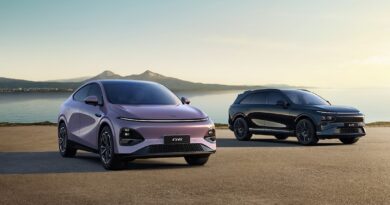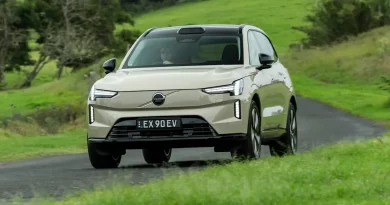Volvo C40 Recharge Pure Electric review
Volvo has some of the most aggressive goals when it comes to brand-wide electrification, and the new C40 Recharge is a big step in its electric charge towards zero emissions. It might share its underpinnings with an ICE vehicle, but it will only ever be sold as an electric vehicle. No half-measures here, then.
Its official name is the Volvo C40 Recharge Pure Electric, and it’s available as either a single motor or dual motor (the latter is called the Twin).
Utilising the architecture and electrical system of the XC40 Pure Electric, the C40 compact SUV will only ever be sold as an EV. Yet underneath is the architecture of an ICE vehicle, one that is also used under the Polestar 2.
READ MORE: Volvo C40 Recharge orders open: All-electric SUV to start at $74,990
Like the XC40, it has an SUV-like ride height but with a more steeply raked roofline that creates a unique look.
It will compete with any of the tech-focused sub-$100K electric car offerings. That includes the Mercedes-Benz EQA, Tesla Model 3, Polestar 2, Kia EV6, Hyundai Ioniq 5 and Volvo’s own XC40 EV.
Value
The Volvo C40 Recharge is priced from $74,990 before on-road costs. That makes it $2000 more expensive than the equivalent XC40 EV – and it also means it misses out on most EV rebates around the country (although NSW buyers won’t pay stamp duty).

There’s also a C40 Recharge Twin (dual motor), which sells for $82,490 plus on-roads.
Both get a panoramic sunroof, smart key entry, electrically adjustable front seats, heated front and rear seats, powered tailgate, dual-zone ventilation, 12.3-inch digital instrument cluster and a 9.0-inch central infotainment screen powered by Google’s Android Automotive operating system.
The single motor model rides on 19-inch wheels while the dual motor Twin gets 20-inch units, each shod in Pirelli tyres.
The C40 Recharge Twin also adds to the equipment list with a 360-degree camera, snazzier seat trim material and a 13-speaker Harman Kardon audio system complete with a subwoofer.
However, none get a rear windscreen wiper, with Volvo suggesting the slope of the rear screen collects less grime.
Safety kit extends to airbags all around, autonomous emergency braking (AEB), blind spot warning, rear cross-traffic alert, a driver monitoring system (to keep an eye on fatigue) and lane keep assist.
Volvo includes a 230V home charger as part of the deal, allowing for slow charging from a regular powerpoint.

Volvo also includes the first three years or 100,000km of servicing (service intervals are every two years and 30,000km). Adding another two years of service coverage costs $1000.
The C40 Recharge is covered by a five-year unlimited kilometre warranty. The high voltage battery gets a separate eight-year, 160,000km warranty that guarantees at least 70 percent of the original capacity.
Inside
It’s all very XC40 inside, although there’s less space and some different materials.
The space component comes down to the different bodies. The XC40 is more of a traditional SUV whereas the C40 has a more raked roofline that drops away at the rear.
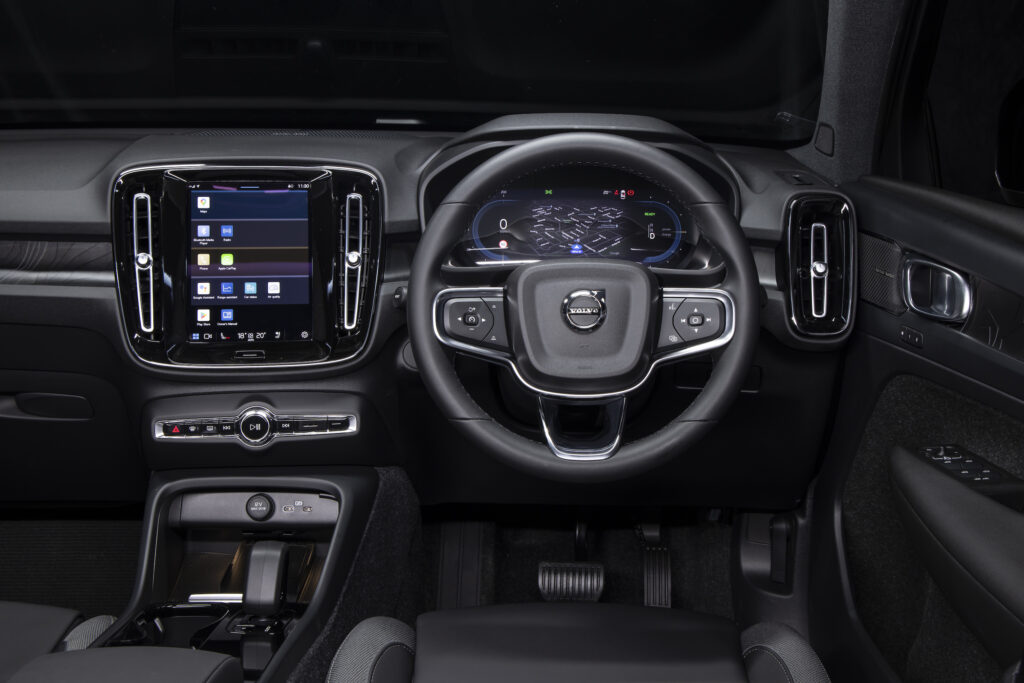
Unsurprisingly, back seat head room suffers, and taller occupants in the C40 may find their heads grazing the roof. For those looking to maximise practicality, the XC40 makes more sense. But it arguably doesn’t look as sexy, hence the reason for being for the C40, which, despite being a small SUV, still has respectable back seat leg room.
Boot capacity has also been reduced, something you’ll only notice if you stack things to the roof. The official capacity is 489 litres, about 15 per cent less than that of the XC40. A 60/40 split-folding back seat makes accommodating chunky items easier.
As with the XC40, the C40 has some underfloor boot storage (there’s a tyre repair kit in lieu of a spare wheel) and a small binnacle under the bonnet.

Despite the similarities between the two – the basic layout and screens are identical – there are notable differences between C and XC.
That comes down partly to the eco sales pitch. Volvo has ambitious sustainability goals and the C40 Recharge takes a step towards that by being the first Volvo that is not available with leather trim.
Not that you’d guess it by looking at the steering wheel; it’s a fine rendition of cow hide.
There are also soft pads on the tops of the doors that provide an acceptable replacement for leather.

On the seats, the base single motor model gets an inoffensive grey and black fabric, while the Twin steps that up to Fusion Microtech that looks a lot more modern.
Both cars do without traditional woods and silver finishes, instead going for something more fun and funky. On the base car there’s a strip across the dash extending into the doors that has a rubber finish with what looks like a map of sorts. The Twin replaces that with black plastic and a topographic-type map pattern.

Switches and dials are sparse but effective, being easy to operate and tactile. There’s a large volume dial for the sound system and the steering wheel buttons work fine once you figure out what the two clusters of buttons control.
Performance and efficiency
Driving the C40 has hints of Tesla in that there is no start button to get things going. Land your bum on the seat and provided you’ve got the key with you, it’s all systems go.
The C40 Recharge gets a single electric motor making 170kW and 330Nm. It drives the front wheels (remember, while the C40 will only ever be an EV, its platform was derived from those used on an internal combustion engine vehicle).
That front-drive dynamic occasionally has the steering wheel tugging with torque steer if you’re powering hard out of an intersection or tight corner.
Performance is thoroughly acceptable around the suburbs and it’ll easily cruise on a freeway. Sure, there’s not the EV urgency some cars display, but the smooth torque surge and effortless nature makes it easy to live with.

Drivers can choose between regular driving or “one-pedal”, the latter bringing with it far more aggressive regeneration (in regular mode it’s very mild) and allowing the car to come to a halt without pressing the brakes.
Electricity use is claimed at 16.8kWh per 100km, which is respectable without being exceptional. The dual motor C40 Recharge Twin uses a lot more, claimed at 22.2kWh/100km.
But it also brings a whole lot more performance. There are two electric motors each making 150kW and 330Nm, for a combined output of 300kW and 660Nm.
The Twin heartily thrusts you back in the seat as it launches to 100km/h in 4.7 seconds. Driving all four wheels also means there’s no chance of slipping as you build pace.
It’s seriously brisk and fun, living up to the sporty looks nicely and making for loads of off-the-mark excitement.
Charging
The C40 Recharge single motor gets a 69kWh battery with a usable capacity of 67kWh. It provides up to 434km of WLTP range, although as is typically the case you can expect a bit less in the real world.
The C40 Recharge Twin steps the capacity up to 78kWh (75kWh usable) for a WLTP range of 420km.
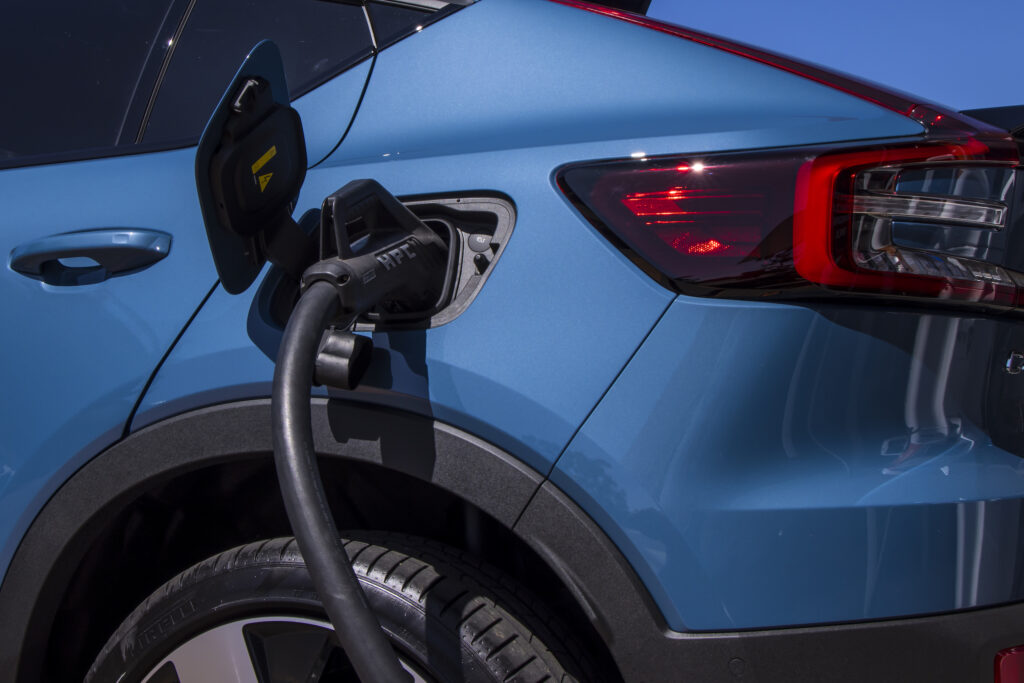
The plug is a CCS Combo, allowing for the common Type 2 AC charging.
Each can charge at up to 11kW using an AC wallbox charger, for a circa-6.5-hour charge in the single motor and seven hours in the dual motor. Using the regular 230V home powerpoint would take about 34 hours and 38 hours respectively for a full charge.
Volvo says a 10-80 percent charge takes about 32 minutes for the single motor and 40 minutes for the Twin, with each able to accept up to 150kW.
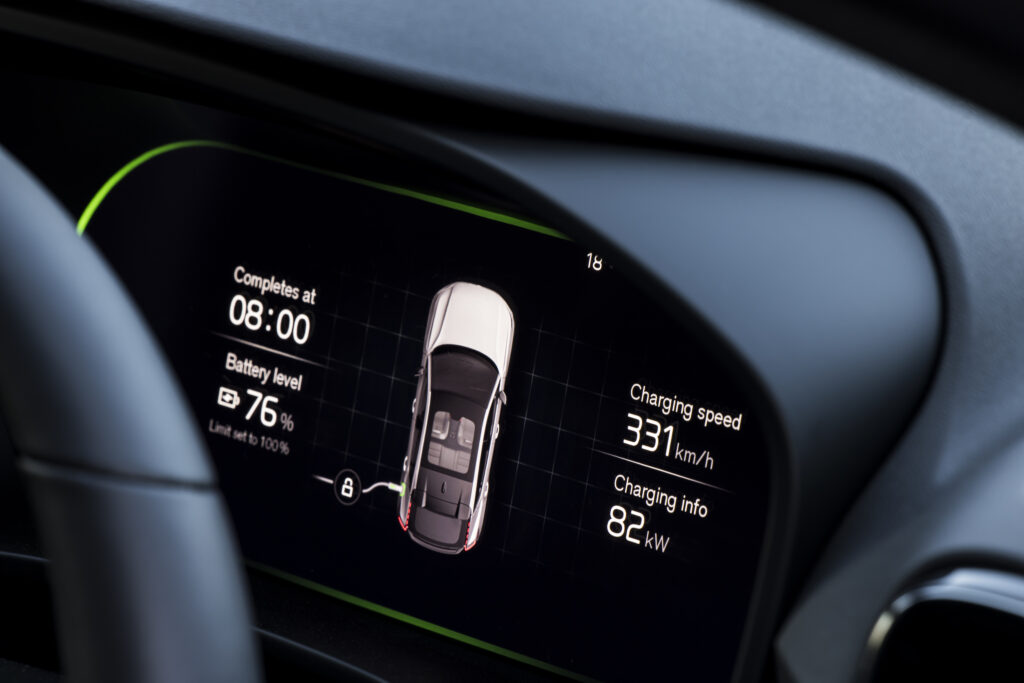
The C40 is not capable of vehicle-to-grid (V2G) or vehicle-to-load (V2L) charging.
Ride and handling
The C40 Recharge has an almost identical ride height and weight to the XC40 Recharge. The C40’s ground clearance is 177mm versus the XC40’s 181mm. And the C40’s unique body is four kilograms lighter than the XC40.

No surprises, then, that there are big similarities between the two.
However, during our first brief drive the C40 seems to have more compliance over bumps, able to soak up smaller imperfections more convincingly.
While you’ll feel the sharper edges – moreso in the Twin with its 20-inch wheels – it’s also relatively well controlled. There’s occasionally some unwanted suspension and tyre noise, but it’s no deal breaker.
Dial up the pace in the dual motor Twin and the dynamic abilities soon reach their limits. Sure, the Pirelli tyres have loads of grip, but the SUV-esque ride height and occasionally rebound over a big bump can make things lively.

None of which affects its day to day liveability. The C40 is fun and engaging and more than up to some engaging driving.
It’s also generally quiet and calm.
Talking point
Equipment levels between the XC40 EV and C40 EV are almost identical, however the C40 does without a rear windscreen wiper; apparently there’s less chance of gunk collecting on it.
Like the XC40, the C40 Recharge gets the Android Automotive operating system run by Google.
That means you can chat to the Google Assistant for basic functions or inputting navigation destinations and you’ll have Google Maps to direct you.

The 9.0-inch screen is arranged in a portrait configuration, but it works fine displaying the various functions embedded within.
And Apple users need not stress: Apple CarPlay is incorporated within, allowing easy connection via a cable. That said, the standard operating system covers off a lot of the functions and you can download various apps from the Google Play store.
There’s also over-the-air software update functionality, so there’s the potential to tweak or add things down the track.
Safety
The Volvo C40 Recharge offers a healthy suite of safety gear, something that helped it achieve a five-star ANCAP safety rating to the 2022 criteria.
There are airbags all around, as well as a knee airbag for the driver and a centre airbag between the front occupants.
Driver assistance systems include a feature to monitor driver fatigue as well as speed sign recognition that displays the speed in the instrument cluster.
There’s also autonomous emergency braking, which occasionally beeps a warning and dabs the brakes when it’s not required (plenty of vehicles do).
Plus it gets rear cross traffic alert (but no rear auto braking), blind spot warning and lane keep assistance with mild steering assistance.
Verdict
The Volvo C40 Recharge is an EV that tugs at the heartstrings as much as the head.
That’s because it’s in part selling on looks. The similar XC40 Recharge has more space and is more affordable, but it doesn’t have the swoopy roofline and distinctive look of the C40.
Like the XC40, the C40 Recharge is fun to drive, moreso as a dual motor Twin.
It also has a classy interior and decent list of equipment, adding to its appeal.

Perhaps its biggest appeal is that you shouldn’t have to queue for yonks to get one. Volvo says it will bring about 1500 into Australia in 2023, alongside around 3500 electric XC40s.
All of which suggests it’s game on for Volvo in the EV space.
Volvo C40 Recharge Pure Electric single motor specifications
Price: $74,990 plus on-road costs
Basics: EV, 5 seats, 5 doors, SUV, FWD
Range: 434km (WLTP)
Battery capacity: 69kWh (67kWh usable)
Battery warranty: 8 years/160,000km (guarantee of 70 percent of original capacity)
Energy consumption: 16.8kWh/100km
Motors: 1 front 170kW/330Nm
AC charging: 11kW, Type 2 plug
DC charging: 150kW, CCS Combo plug
0-100km/h:
Volvo C40 Recharge Pure Electric Twin specifications
Price: $74,990 plus on-road costs
Basics: EV, 5 seats, 5 doors, SUV, AWD
Range: 420km (WLTP)
Battery capacity: 78kWh (75kWh usable)
Battery warranty: 8 years/160,000km (guarantee of 70 percent of original capacity)
Energy consumption: 22.2kWh/100km
Motors: 1 front 150kW/330Nm and 1 rear 150kW/330Nm
AC charging: 11kW, Type 2 plug
DC charging: 150kW, CCS Combo plug
0-100km/h: 4.7 seconds


